Filling bird feeders is a favorite hobby for about half of all U.S. families. This shows many people love watching birds in their yards. But have you ever wondered how birds find the new feeding spots you set out? Birds use their sharp eyes and ears to locate these food sources, even if they’re brand new in the area.
Birds rely mainly on what they see to find food. Their sense of smell is not as strong, so visual cues matter a lot. Where you place your bird feeders is key for attracting birds. It may take birds from a few hours to a few weeks to find your feeders. This timing depends on many things.
Key Takeaways
- Birds rely on their keen sense of sight to locate food sources, including bird feeders.
- The time it takes for birds to discover new feeders can range from a few hours to several weeks, depending on factors like feeder visibility and location.
- Providing a variety of high-quality bird food and a reliable water source can help attract and retain birds at your feeders.
- Seasonal variations in bird species can lead to a diverse array of feathered visitors throughout the year.
- Monitoring feeder activity and adjusting placement as needed can help ensure your backyard birds find and use the feeding stations you provide.
Attracting Feathered Friends: How Birds Locate Bird Feeders
Understanding birds’ senses is key to bringing them to your yard. Birds rely mainly on their sharp eyesight to find food sources, like bird feeders. Place your feeder carefully. Think about how visible and easy to reach it is. This makes it more attractive for our winged buddies.
Bird Vision and Senses: The Key to Finding Food
Birds have great eyesight. They can see food from far away. Their eyes pick up on movement, color, and contrast, aiding in finding your feeder. They also see a wider area than we can, which helps them check out the landscape better.
Birds also use smell and hearing to find food. These senses are not main, like vision is. But still, they help birds locate your feeder.
The Importance of Visibility and Location
Where you put your feeder matters. Put it in the open but safe, with nearby trees or bushes. This way, birds find it easily and feel safe when they come to feed.
The feeder type affects who comes. For example,
tube feeders can bring small and medium birds. Suet feeders attract insects eaters like woodpeckers.
Knowing about bird vision and senses, plus where to place your feeder, helps. You can make a space that is welcoming and easy for many birds to visit.
Adding a New Feeder: What to Expect
Adding a new bird feeder to your yard changes things. It’s key to know how long it takes birds to spot it. This process can happen fast, in a few hours, or it might drag on for weeks. It all depends on many things.
Time Frame for Discovery
Finding a new feeder can take birds from one to two weeks on average. Some birds might show up the same day you set it out. Others might not visit for a month. This adds new joy and anticipation to your yard.
Factors That Influence Feeder Visibility
- Proximity to existing feeders or natural food sources: Birds spot a new feeder quicker if it’s close to where they already eat.
- Feeder placement and visibility: Placing feeders where birds can easily see them speeds up their discovery.
- Feeder design and protection: Feeders that are squirrel-proof or stand up well to weather attract more birds.
- Time of year: Winter makes birds more open to new feeding spots since food can be scarce.
Thinking about these factors and trying different spots for your feeder helps. It makes certain more birds come to your yard’s new dining area.
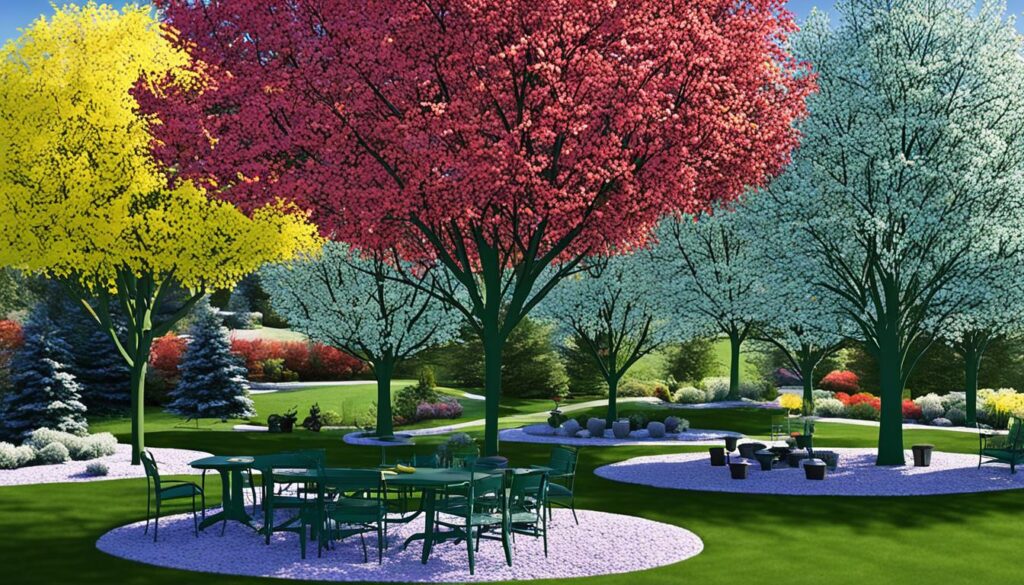
“Attracting birds to a new feeder is all about making it as visible and accessible as possible. Placement, design, and timing can all play a crucial role in how quickly your feathered friends find and start using the new feeding station.”
Moving or adding a feeder means taking all these into account. Knowing how and when your feeder gets noticed is essential. It makes your garden a warm welcome for local birds.
Transitioning to a New Feeding Station
Moving a bird feeder to a new location in your yard requires a gentle hand. It’s best to do it slowly. This way, birds won’t get too stressed over the change. They’ll also keep their normal feeding times.
Gradual Relocation for Seamless Transition
Birds like their routines but can get used to new things if given time. Move the feeder a bit closer to the new spot each day. This lets the birds get used to their new feeding area step by step.
Watch how the birds react as you move the feeder. If they’re not adjusting, consider slowing the process. Or, you might need to move the feeder back a bit closer to its original spot. The main goal is to make the change easy for the birds.
Changing the feeding spot is tricky but doable with care. Step by step, you can make the new place feel just like home to your birds. Doing this will ensure they keep coming back and brighten up your yard.
Seasonal Considerations for Feeder Placement
Bird feeders are great no matter the season. Birds use them all year for different reasons like flying south or raising their chicks. Setting up feeders year-round brings a variety of birds to your garden.
Birds especially need the feeders during tough times like extreme weather or when natural seeds are scarce. In areas with many homes, birds might find food elsewhere. But in severe weather, they rely on feeders.
When placing the feeders, keep them 12 feet from any hiding spots like bushes. This stops cats from catching the birds. Also, think about placing them far from windows to prevent bird crashes. Use different feeder styles to welcome more bird types.
It’s also important to clean the feeders often. This keeps birds healthy by avoiding sharing diseases. With the right feeder placement and types, you can make a safe and friendly spot for all kinds of birds in your yard.
Tailoring Feeders for Seasonal Needs
Provide the right food for birds as each season changes:
- Winter: Black-oil sunflower seeds, white proso millet, peanuts, suet cakes, nyjer seed, and cracked corn
- Spring: Fruit, eggshells, and nesting materials
- Summer: Nectar for hummingbirds and nyjer seed for goldfinches
- Fall: Millet, peanuts, peanut butter, and suet cakes
| Season | Recommended Bird Feeder Foods |
|---|---|
| Winter | Black-oil sunflower seeds, white proso millet, peanuts, suet cakes, nyjer seed, cracked corn |
| Spring | Fruit, eggshells, nesting materials |
| Summer | Nectar for hummingbirds, nyjer seed for goldfinches |
| Fall | Millet, peanuts, peanut butter, suet cakes |
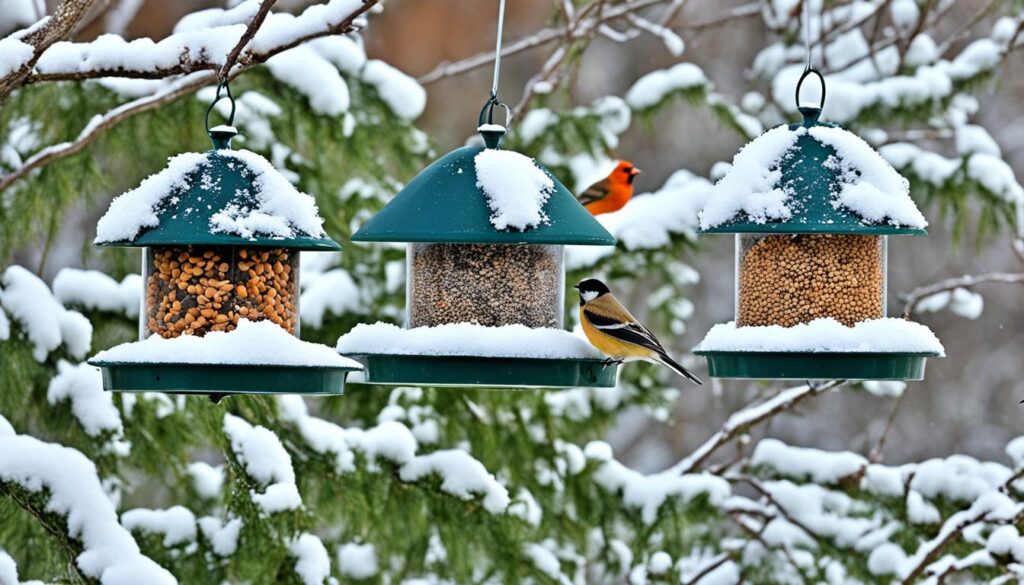
To make your backyard a bird paradise, match your feeders to the season. This ensures you’re always ready for a new flock of visitors. With thoughtful feeder choices, birds will feel right at home all year.
How Do Birds Find Bird Feeders?
Birds search for food using their sharp vision. They easily spot bird feeders in your yard. This is because birds don’t have a good sense of smell like we do. They rely on their far-reaching eyesight.
The sound of flowing water can also pull birds to a feeder. It hints at a nearby water source. Knowing this, you can place your feeder where it’s easy for birds to see and reach.
- Most birds have excellent eyesight, which they use to search for food from a distance.
- Birds have a poor sense of smell, relying primarily on their vision to locate food sources.
- The sound of moving water can also draw birds to a feeder, as it suggests the presence of a nearby drinking source.
Birds might not find a new feeder right away. It often takes about a week for them to notice it. Songbirds are especially careful. They could take a few weeks to warm up to a new feeder.
Make your feeder stand out by spreading some seed near it. This can attract birds’ attention. Also, hanging a new feeder close to the old one helps birds spot it faster.
Having patience and knowing about bird senses is crucial. With the right food and feeder setup, you will turn your yard into a bird haven. This way, birds will want to come back again and again.
Feeder Type and Seed Preferences
The feeder you use and the seed you put in it are key to attracting birds. Birds like different types of food, such as birdseed and suet. You should pick your feeder based on the birds in your area. This way, you offer the right food for them.
Tailoring Feeders to Local Bird Species
Birds have their favorite foods. For example, many love sunflower seeds, millet, and cracked corn. Others, like finches, prefer Nyjer seeds or bluebirds, which enjoy mealworms. By using a variety of feeders and food, you can bring different bird types to your yard.
Some feeders are best for certain birds. For instance, tube feeders work well for small birds. On the other hand, platform feeders are great for doves and sparrows. To attract hummingbirds, you’ll need a feeder with nectar. And, window feeders can bring more birds to see up close.
It’s vital to keep your feeders clean to avoid spreading diseases. When your feeding spot is clean, your birds will be healthier. This makes for a happier bird-watching experience for you.
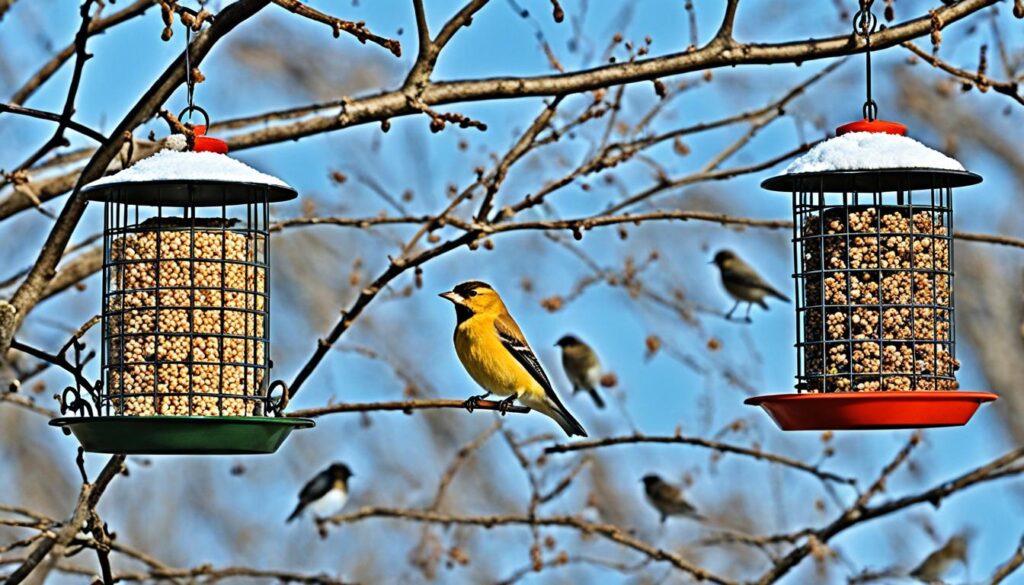
Most birds enjoy sunflower seeds, particularly black oil and striped varieties. Safflower seeds are loved by cardinals and grosbeaks. Then there’s nyjer seed, a hit among finches like American Goldfinches.
Learning about your local birds helps you pick the right seeds and feeders. This ensures your backyard is always full of bird activity.
Creating a Welcoming Environment
Having a bird-friendly yard goes beyond the look of bird feeders. It also means having a water source available. Birds need water to drink and for baths. A birdbath, fountain, or shallow dish with clean water can attract many bird types.
It’s just as key to provide cover and shelter for birds. Plant dense bushes and evergreen trees in your yard. This offers birds a safe place from predators and bad weather. They’ll feel secure enough to visit your feeders often.
Water Sources and Cover for Birds
Key elements for a bird-friendly space include:
- Adding a birdbath or water feature for a reliable water source.
- Using dense shrubs and trees to make cover and shelter for birds.
- Choosing native plants over pesticides. Native plants attract insects, a bird favorite.
- Keeping your water features clean to offer fresh water always.
By focusing on these, you make your yard a bird-friendly haven. It will bring in many birds and create a healthy ecosystem in your space.
“A reliable water source and natural cover can be just as important as the feeders themselves in creating an inviting environment for birds.”
Troubleshooting Feeder Placement
As you work to attract more birds, where you put your feeders matters. You need to think about keeping them safe from predators and pests. Making sure they’re easy to see and reach can really boost your bird-watching fun.
Avoiding Predators and Pests
Put your feeders where they’re less likely to attract predators such as cats, hawks, or squirrels. Keeping them 10-15 feet away from spots these animals might hide, like trees or fences, helps. Also, consider using squirrel-proof bird feeders that are harder for these animals to use.
Don’t forget to keep an eye on your feeders. Clean them once a week to stop mold and bacteria growth. If you notice any pests or predators, deal with them quickly to protect your birds.
“Outdoor cats cause human-caused bird mortality, making it the most significant source of mortality for birds,” according to the American Bird Conservancy.
Thinking ahead and taking steps to safeguard your feeders will make your yard a welcoming place for birds. This way, they can visit without feeling threatened.
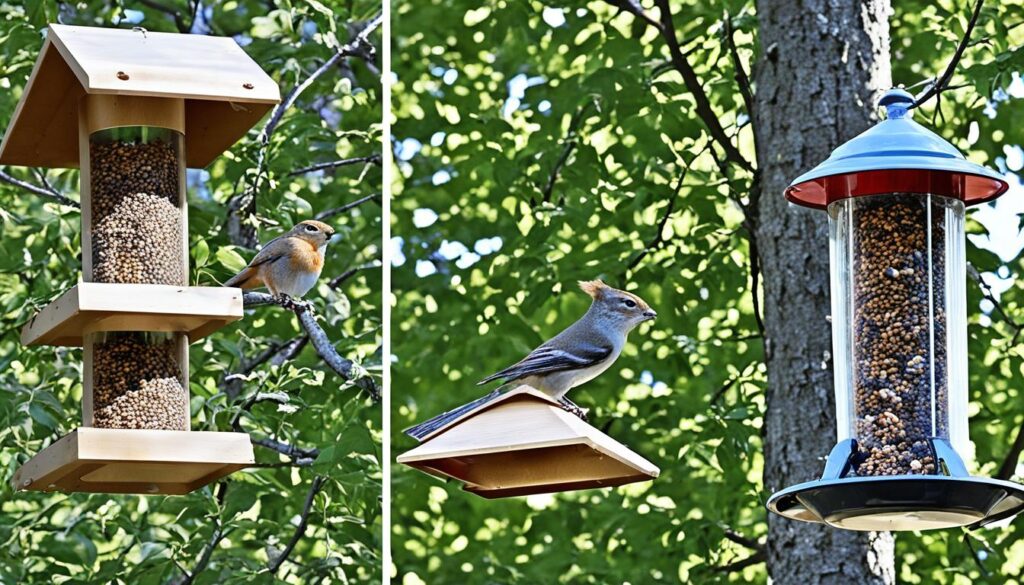
Where you place your feeders is key, just like the food you provide. Be smart about where they go, and your birds will have a great, safe space to enjoy.
Conclusion
Birds use their sharp senses, especially their great eyesight, to find food like bird feeders. You can make your yard attractive to many bird species this way. Think about where you place your feeders, how visible they are, and their distance from hiding spots.
To see more birds, be patient and try different things. Keeping your feeders clean and filled is key. Each bird type likes different foods and feeders. By knowing this, you’ll bring more kinds of birds to enjoy.
Want more birds in your yard? Use the tips in this article. They’ll help you make a place birds love. Your yard can help local birds thrive. Plus, it’ll be a spot you and your family love to watch birds in.
FAQ
How do birds find bird feeders in my yard?
Birds see food and react fast. They rely on sight and sound to find bird feeders. Once they spot a feeder, they remember it as a food spot. Then, they come back.
What factors influence how quickly birds discover a new bird feeder?
Where you put the feeder matters a lot. Placing it openly, near safe cover, and away from threats helps birds find it. This makes the feeder more obvious and safe, which birds like.
How long does it typically take for birds to find a new bird feeder?
It takes time for birds to find a new feeder. It could be fast or take weeks. How many birds are nearby, other feeders, and how easy the feeder is to spot influence this.
What should I do when relocating an existing bird feeder?
Move the feeder slowly to its new spot. Letting birds see both the old and new spots helps them adjust. This way, they keep using the feeder happily.
Is there a best time of year to set out bird feeders?
Bird feeders work well all year long. Birds need food for many reasons, like migrating or parenting. You may see different birds depending on the season.
How do birds use their senses to locate bird feeders?
Birds use their sharp sight to find food, including feeders. They don’t have a strong sense of smell. Sound, like from water, may also attract them as it signals a drinking spot nearby.
How can I attract a variety of bird species to my bird feeders?
It’s about the right feeder and food. Use various feeders and seeds for different birds. This way, you welcome a wider range of species to your place.
What other factors can help attract birds to my yard?
Apart from the feeder, make your yard bird-friendly. A clean water source and natural cover make birds feel safe. This encourages them to visit more often.
How can I protect my bird feeders from predators and pests?
Keep feeders safe from cats and hawks by smart placement and designs. Watch over the feeders and adjust as needed for a bird-safe spot.
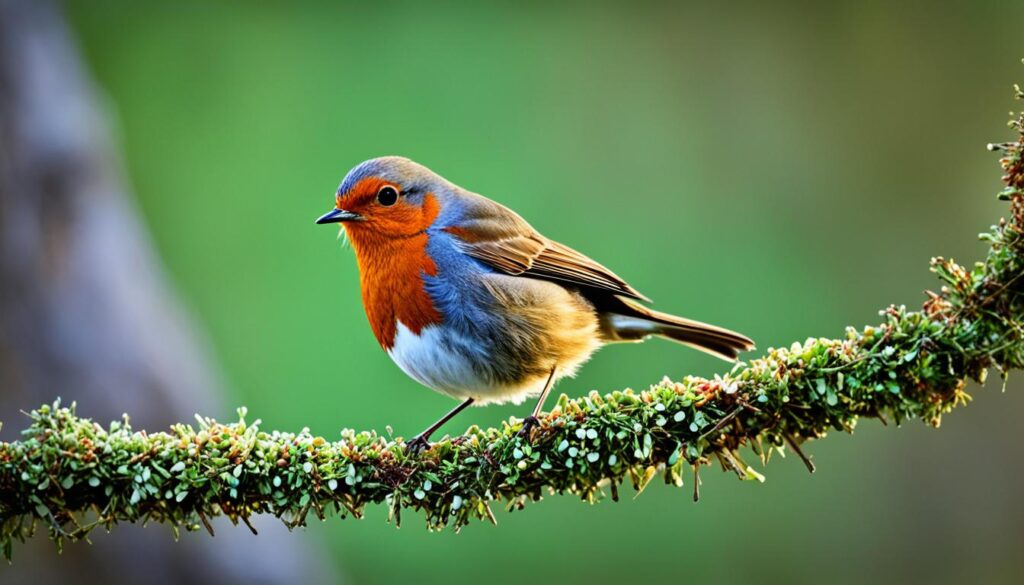

Hello there! Do you know if they make any plugins to help with
Search Engine Optimization? I’m trying to
get my website to rank for some targeted keywords but I’m not seeing very good results.
If you know of any please share. Appreciate it!
I saw similar text here: Eco blankets
Hello there! Do you know if they make any plugins to help with SEO?
I’m trying to get my blog to rank for some targeted keywords but I’m not seeing very good success.
If you know of any please share. Many thanks!
You can read similar art here: Code of destiny
I am really impressed with your writing abilities as smartly as with the format on your blog.
Is this a paid theme or did you customize it yourself?
Anyway keep up the excellent high quality writing, it’s rare to look a great blog like this
one these days. Snipfeed!
I am extremely inspired along with your writing talents as well as with the structure in your weblog.
Is that this a paid subject or did you modify it your self?
Either way stay up the excellent quality writing, it is uncommon to peer a great blog like
this one nowadays. Blaze ai!
I’m extremely inspired with your writing skills as well as with the format for your blog. Is this a paid topic or did you modify it yourself? Anyway stay up the nice quality writing, it is rare to peer a great blog like this one these days. I like talkbirds.com ! It’s my: Stan Store alternatives
I am extremely inspired along with your writing skills as smartly as with the layout
in your weblog. Is this a paid subject matter or did you customize it yourself?
Either way keep up the excellent quality writing, it is uncommon to peer a nice blog like this one
nowadays. Snipfeed!